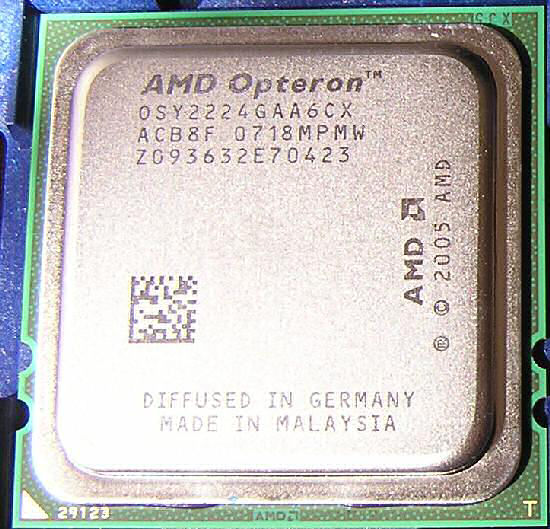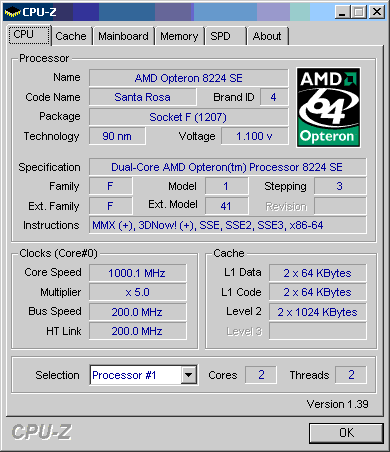A Closer Look at AMD's Newest Offering
AMD thus brings four new CPUs into the server space:

The Opteron 2224 package
To position AMD's new Opteron 2224 offering we take a look at the most interesting Intel and AMD CPUs at the current date.
So basically, AMD's 120W Dual core 3.2GHz Opteron has to prove that it is a worthy competitor to two Intel offerings:
This means that the software only has to make use of two CPU cores (eight cores needs four instances), which is a lot easier than making use of all eight cores in a single instance. This kind of "multi instance" benchmarking may reflect the way quite a few people and businesses use their servers, but at the same time such benchmarks can paint a picture that is far too optimistic for those people who are only running one application on their server.
Secondly, it might seem like a dual Opteron 2224 needs 80W more, but the reality is different. Intel's Northbridge consumes up to 20W more, and each FB-DIMM needs about 5W more than the DDR modules the AMD platform uses. So the difference is not as big as it might seem at first, something we have shown in a previous article. The AMD CPUs also scale back to 1GHz when running at idle, while the Intel CPUs run at 1.6 or 2GHz when idle. As a result the AMD platforms can consume less power when idle or at lower loads.

The Opteron runs now at 3.2GHz
As you can see in the animated gif above, the CPU is capable of scaling back to 1GHz and 1.1V. It can also run at 2.8GHz at 1.275V, and it needs 1.375V to run at 3.2GHz. PowerNow! enables it to run at any frequency between 1.6GHz to 2.8GHz in steps of 200MHz. Keep this in mind when we look at some power figures later on.
AMD thus brings four new CPUs into the server space:
- A 3.2GHz Opteron which consumes at most 120W, in dual and quad/octal socket versions
- A 3GHz Opteron 8222 and 2222 which used to consume up to 120W, but which are - thanks to process improvements - now limited to 95W

The Opteron 2224 package
To position AMD's new Opteron 2224 offering we take a look at the most interesting Intel and AMD CPUs at the current date.
| Intel Processor Overview | ||||||||
| Intel CPU | Clock | Codename | L2 | L3 | FSB | Mem bandwidth | TDP | Price |
| Dual NetBurst CPUs | ||||||||
| Xeon MP 7140M | 3.4GHz | Tulsa | 2x1MB | 16MB | 200MHz Quad | 6.4 GB/s | 150W | $1,980 |
| Xeon MP 7130M | 3.2GHz | Tulsa | 2x1MB | 8MB | 200MHz Quad | 6.4 GB/s | 150W | $1,391 |
| Xeon MP 7120M | 3GHz | Tulsa | 2x1MB | 4MB | 200MHz Quad | 6.4 GB/s | 95W | $1,117 |
| Quad Core CPUs | ||||||||
| Xeon E5355 | 2.66GHz | Clovertown | 2x4MB | - | 333MHz Quad | 21 GB/s | 120W | $1,172 |
| Xeon E5345 | 2.33GHz | Clovertown | 2x4MB | - | 333MHz Quad | 21 GB/s | 80W | $851 |
| Xeon E5320 | 1.86GHz | Clovertown | 2x4MB | - | 266MHz Quad | 17 GB/s | 80W | $690 |
| Dual Core CPUs | ||||||||
| Xeon DP 5160 | 3GHz | Woodcrest | 4MB | - | 333MHz Quad | 21 GB/s | 80W | $851 |
| Xeon DP 5150 | 2.66GHz | Woodcrest | 4MB | - | 333MHz Quad | 21 GB/s | 65W | $690 |
| Xeon DP 5148 | 2.33GHz | Woodcrest | 4MB | - | 333MHz Quad | 21 GB/s | 40W | $519 |
| AMD Processor Overview | ||||||||
| AMD CPU | Clock | Codename | L2 | L3 | HT | Mem bandwidth | TDP | Price |
| Eight-Way CPUs | ||||||||
| Opteron 8224 SE | 3.2GHz | Santa Rosa | 2x1MB | - | 1000MHz DDR | 10.6 GB/s | 119W | $2,149 |
| Opteron 8222 | 3GHz | Santa Rosa | 2x1MB | - | 1000MHz DDR | 10.6 GB/s | 95W | $1,514 |
| Opteron 8220 | 2.8GHz | Santa Rosa | 2x1MB | - | 1000MHz DDR | 10.6 GB/s | 95W | $1,165 |
| Opteron 8218 | 2.6GHz | Santa Rosa | 2x1MB | - | 1000MHz DDR | 10.6 GB/s | 95W | $873 |
| Opteron 8218 HE | 2.6GHz | Santa Rosa | 2x1MB | - | 1000MHz DDR | 10.6 GB/s | 68W | $1,019 |
| Two-Way CPUs | ||||||||
| Opteron 2224 SE | 3.2GHz | Santa Rosa | 2x1MB | - | 1000MHz DDR | 10.6 GB/s | 119W | $873 |
| Opteron 2222 | 3GHz | Santa Rosa | 2x1MB | - | 1000MHz DDR | 10.6 GB/s | 95W | $698 |
| Opteron 2220 | 2.8GHz | Santa Rosa | 2x1MB | - | 1000MHz DDR | 10.6 GB/s | 95W | $523 |
| Opteron 2218 | 2.6GHz | Santa Rosa | 2x1MB | - | 1000MHz DDR | 10.6 GB/s | 95W | $377 |
| Opteron 2218 HE | 2.6GHz | Santa Rosa | 2x1MB | - | 1000MHz DDR | 10.6 GB/s | 68W | $450 |
So basically, AMD's 120W Dual core 3.2GHz Opteron has to prove that it is a worthy competitor to two Intel offerings:
- The dual core Xeon 5160 3GHz with a TDP of 80W
- The quad core Xeon 5345 2.33 with a TDP of 80W
This means that the software only has to make use of two CPU cores (eight cores needs four instances), which is a lot easier than making use of all eight cores in a single instance. This kind of "multi instance" benchmarking may reflect the way quite a few people and businesses use their servers, but at the same time such benchmarks can paint a picture that is far too optimistic for those people who are only running one application on their server.
Secondly, it might seem like a dual Opteron 2224 needs 80W more, but the reality is different. Intel's Northbridge consumes up to 20W more, and each FB-DIMM needs about 5W more than the DDR modules the AMD platform uses. So the difference is not as big as it might seem at first, something we have shown in a previous article. The AMD CPUs also scale back to 1GHz when running at idle, while the Intel CPUs run at 1.6 or 2GHz when idle. As a result the AMD platforms can consume less power when idle or at lower loads.

The Opteron runs now at 3.2GHz
As you can see in the animated gif above, the CPU is capable of scaling back to 1GHz and 1.1V. It can also run at 2.8GHz at 1.275V, and it needs 1.375V to run at 3.2GHz. PowerNow! enables it to run at any frequency between 1.6GHz to 2.8GHz in steps of 200MHz. Keep this in mind when we look at some power figures later on.










30 Comments
View All Comments
Spoelie - Monday, August 6, 2007 - link
Thanks for the clarification, I was under the impression the only real states were idle (1ghz) and full tilt (3.2ghz). Never seen any other states but all I ever use are the desktop chips, I wasn't aware CnQ could be more dynamic than that.yuchai - Monday, August 6, 2007 - link
I believe all A64 chips including the desktop ones have the different power states. For example my X2 4200+ has 4 states. 1.0, 1.8, 2.0 and 2.2 Ghz.ButterFlyEffect78 - Monday, August 6, 2007 - link
Are they talking about the barcelona?If not, then this is old news.
I'm sure everyone by now knows that intels new cpu's are better then the current AMD opterons.
KingofFah - Monday, August 6, 2007 - link
It really isn't. The were demonstrating the new 3.2ghz opteron. Also, this was a dual socket setup, and anand said, and everyone who monitors the server world knows, that the opterons come out ahead overall in the 4S environment.The more sockets, the more performance advantage opterons have on intel in the server space. This is well known. The purpose of this was to show it in the dual socket environment.
duploxxx - Monday, August 6, 2007 - link
confused, no it is the stupidity of people like you that think that all Intel offerings are better then the ones for AMD.@anand, you're conclusion of the database world that the quadcore still rules..... where are the benchmarks?
now it is nice to see all these benches next to each other, when are you going to combine benches, no longer servers are used for one application, they are more combined these days with more apps. Maybe its time you also have a look at vmware esx etc.... will probably give you a different look at the offerings of AMD these days.
clairvoyant129 - Monday, August 6, 2007 - link
You don't have to get hostile because he does have a point. In the desktop market, Intel is clearly better unless we're talking about low end. Server market, it's still a toss up but Intel still has a lead.yyrkoon - Monday, August 6, 2007 - link
Um, you guys obviously have not been paying much attention have you ?1) AMD CPUs=cheaper
2) AMD CPUs of comparrible speed perform nearly as good if not as good or better than their Intel counterparts. ie: I think you better check the last benchmarks anandtech post 'homie', because I saw a lot of AMD on top of the game benches. (6000+ vs e6600).
3) Yes, a C2D *may* overclock better, and if it is you intention to overclock, it makes perfect sense to buy one, just be prepared to pay more for the CPU.
4) Up until recently, or possibly still happening into the near future, AMD system boards availible often offered more features for less cost. It does seem however with the P35 Chipset, vendors are starting to come around.
5) last, but not least, THIS article IS NOT about desktop hardware now IS IT ?! why bring some stupid lame ass coment into some place that it does not even fit ? GOd, and I thought I needed a new life . . .
Final Hamlet - Monday, August 6, 2007 - link
It is these "but"s, that make the difference.If they exist, you can't state "all Intel CPUs" anymore, because there are exceptions.
ButterFlyEffect78 - Monday, August 6, 2007 - link
I'm sorry everybody.English is my 2nd language so I sometimes can't always express what I want to say.
What i meant to say is that Intel's new line of cpu's based on Core 2 duo tech. are better-(more advanced) then those based on K8 technology. If this is not true then there should not be a reason to introduce the K10 later this year to counterattack core 2 duo/quad.
But again, I could be wrong.
Calin - Monday, August 6, 2007 - link
Core2Duo technology from Intel is better overall than the K8 technology from AMD - this includes basic architecture, current improvements on the initial architecture (K8 is older and has more of those small improvements), and process/production technology.However, Intel lagged in introduction of Core2 based server processors, and even now their FBDIMM technology is slower and hotter (power hungry) than AMD's Opteron/DDR. Until this changes, AMD still has a market in servers, albeit not as good as before the Core2Duo Xeon processors.